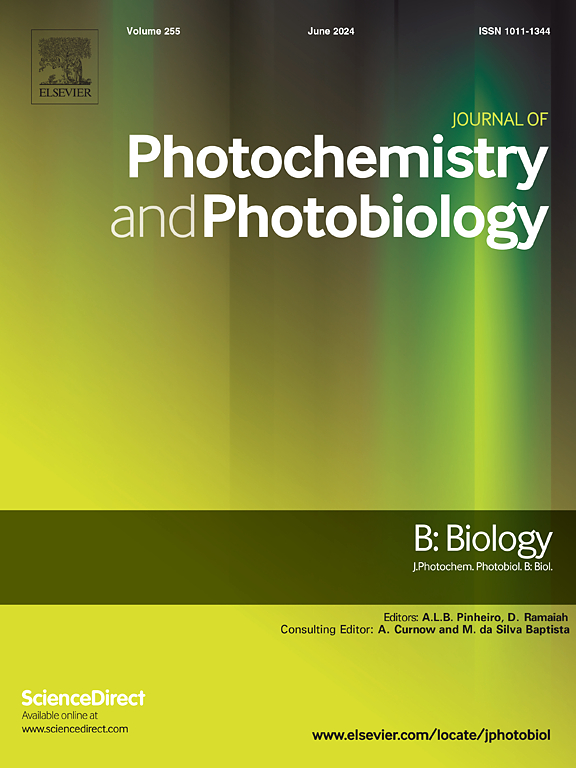酶促刺玫通过Nrf2/ARE和MAPK/NF-κB通路调节细胞凋亡,减轻紫外线诱导的皮肤光损伤。
IF 3.9
2区 生物学
Q2 BIOCHEMISTRY & MOLECULAR BIOLOGY
Journal of photochemistry and photobiology. B, Biology
Pub Date : 2025-02-01
DOI:10.1016/j.jphotobiol.2025.113098
引用次数: 0
摘要
暴露于紫外线照射下会导致皮肤细胞异常、广泛的凋亡。这种过度的细胞死亡会促进炎症并改变微环境,增加患皮肤癌的风险。尽管进行了广泛的研究,但很少有材料能同时有效地防护UVA和UVB辐射。本研究旨在利用酶促提取法制备双作用材料,以防止UVA和UVB辐射对皮肤造成的光损伤。使用三种不同的酶来辅助提取RD,然后分析活性成分水平的变化。将正常人真皮成纤维细胞(NHDF)和HaCaT细胞分别置于UVA和UVB照射下,建立皮肤光损伤模型。采用流式细胞术评估酶辅助提取RD (ERD)对活性氧(ROS)产生和细胞凋亡的影响。ELISA检测ERDs对炎症因子的影响,RT-PCR检测ERDs对光损伤细胞凋亡基因表达的影响。此外,通过Western blot分析ERDs对核因子-红细胞2相关因子2 (Nrf2)/抗氧化反应元件(ARE)和丝裂原活化蛋白激酶(MAPK)/核因子-κB (NF-κB)信号通路的影响。最后,通过苏木精和伊红(H&E)染色评估ERDs对紫外线照射后全层人工皮肤组织的影响。此外,结合实验结果,利用网络药理学探索erd在预防皮肤癌方面的潜力。ERDs通过调节Nrf2/ARE和抑制MAPK/NF-κB信号通路,有效降低ROS水平,抑制肿瘤坏死因子(TNF)-α、白细胞介素(IL)-1β和IL-6的分泌。该机制促进抗凋亡基因Bcl-2的表达,降低促凋亡基因BAX、caspase-3、caspase-9的活性,从而对抗紫外线诱导的细胞凋亡。此外,染色结果表明,erd能有效修复紫外线引起的光损伤,保持皮肤结构的完整性。ERDs提供全面的防护,防止UVA和UVB辐射造成的光损伤,显示其作为一种有效的光防护材料的潜力,并可能预防皮肤癌。本文章由计算机程序翻译,如有差异,请以英文原文为准。

Enzyme-assisted Rosa davurica mitigates UV-induced skin photodamage by modulating apoptosis through Nrf2/ARE and MAPK/NF-κB pathways
Exposure to UV irradiation results in abnormal, extensive apoptosis of skin cells. This excessive cell death can promote inflammation and alter the microenvironment, increasing the risk of skin cancer. Despite extensive research, few materials are effective at simultaneously protecting against both UVA and UVB irradiation. This study aims to develop dual-action material using enzyme-assisted extraction of Rosa davurica Pall (RD) to prevent skin photodamage caused by UVA and UVB irradiation. Three different enzymes were used to assist the extraction of RD, followed by an analysis of the changes in active component levels. Skin photodamage models were established by exposing Normal Human Dermal Fibroblasts (NHDF) and HaCaT cells to UVA and UVB irradiation. The impact of enzyme-assisted extracted RD (ERD) on Reactive Oxygen Species (ROS) production and cell apoptosis was assessed using Flow Cytometry. The effects of ERDs on inflammatory cytokines were measured using ELISA, and RT-PCR was used to evaluate its impact on apoptotic gene expression in photodamaged cells. Furthermore, the impact of ERDs on the Nuclear factor erythroid 2-related factor 2 (Nrf2)/Antioxidant response element (ARE) and Mitogen-activated protein kinases (MAPK)/Nuclear factor-κB (NF-κB) signaling pathways was assessed through Western blot analysis. Finally, the impact of ERDs on full-thickness artificial skin tissue after UV irradiation was assessed using hematoxylin and eosin (H&E) staining. Furthermore, leveraging the experimental results, network pharmacology was utilized to explore the potential of ERDs in preventing skin cancer. Enzyme-assisted extraction enhanced the bioactive components of RD. ERDs effectively reduced ROS levels and suppressed the secretion of Tumor necrosis factor (TNF)-α, Interleukin (IL)-1β, and IL-6 by modulating the Nrf2/ARE and inhibiting the MAPK/NF-κB signaling pathways. This mechanism promoted the expression of the anti-apoptotic gene Bcl-2 and decreased the activity of proapoptotic genes BAX, caspase-3, and caspase-9, thereby countering UV-induced apoptosis. Additionally, staining results demonstrated that ERDs effectively repaired UV-induced photodamage and maintained the integrity of skin structure. ERDs provides comprehensive protection against photodamage induced by UVA and UVB irradiation, demonstrating its potential as an effective photoprotective material and possibly in preventing skin cancer.
求助全文
通过发布文献求助,成功后即可免费获取论文全文。
去求助
来源期刊
CiteScore
12.10
自引率
1.90%
发文量
161
审稿时长
37 days
期刊介绍:
The Journal of Photochemistry and Photobiology B: Biology provides a forum for the publication of papers relating to the various aspects of photobiology, as well as a means for communication in this multidisciplinary field.
The scope includes:
- Bioluminescence
- Chronobiology
- DNA repair
- Environmental photobiology
- Nanotechnology in photobiology
- Photocarcinogenesis
- Photochemistry of biomolecules
- Photodynamic therapy
- Photomedicine
- Photomorphogenesis
- Photomovement
- Photoreception
- Photosensitization
- Photosynthesis
- Phototechnology
- Spectroscopy of biological systems
- UV and visible radiation effects and vision.

 求助内容:
求助内容: 应助结果提醒方式:
应助结果提醒方式:


